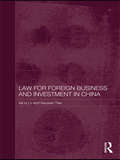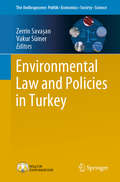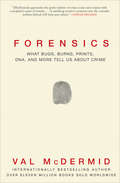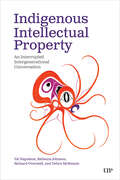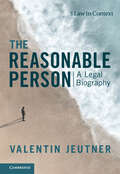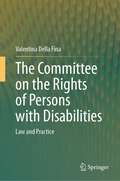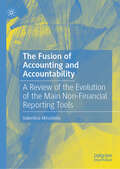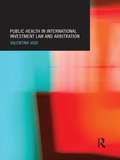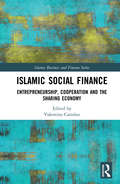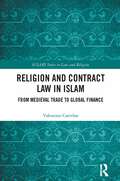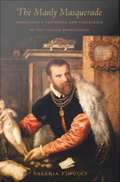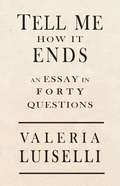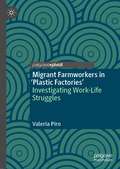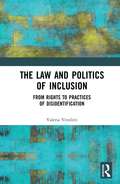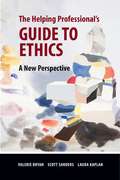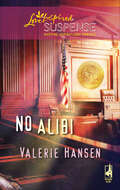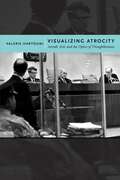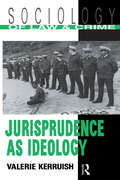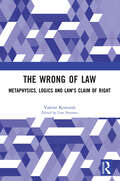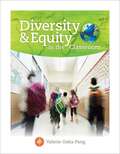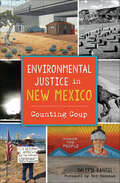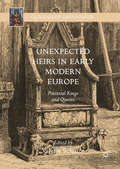- Table View
- List View
Law for Foreign Business and Investment in China
by Xiaowen Tian Vai Io LoIn trying to establish a presence in China, foreign investors have found it imperative to understand the regulatory environment of this potentially huge market. This book provides an up-to-date overview of the legal framework for doing business in China. It covers such topics as state structure; legislative amendments and enactments on direct foreign investment; the court system; the legal profession; business entities; foreign investment enterprises; contracts; intellectual property; labor and employment; consumer protection; taxation; securities; and dispute resolution. Apart from explaining legal principles, the book highlights liberalisation measures that China has undertaken to fulfil its WTO commitments; elucidates complicated legal concepts with examples of court decisions; discusses relevant foreign trade and investment polices; and includes a glossary of Chinese terms.
Environmental Law and Policies in Turkey (The Anthropocene: Politik—Economics—Society—Science #31)
by Vakur Sümer Zerrin SavaşanThis book aims to provide a general systematic analysis of key issues of Turkish environmental law and policies and to highlight the related concerns and challenges. Its chapters provide a historical perspective and general understanding of the legal settings of Turkish Environmental Law; offer an overall understanding of the evolving and prevailing paradigms of legislation and administrative practices in environmental policy in Turkey; explain how EIA has become the main environmental management tool and instrument of environmental compliance in Turkey; discuss the project process, challenges and results of the EU-funded project ‘Turkey’s Map of Environmental Violations’ and food security in Turkey; and present a picture of environmental justice movements from bottom-up over the establishment and operation of small-scale hydroelectricity power plants.Thus, with its comprehensive coverage of up-to-date information and findings enabling the reader to understand the topic in full analyses of key themes in Turkish environmental law and policies, addressing, in separate chapters, concepts like environmental justice, food security, environmental compliance, environmental impact assessment (EIA), and environmental cases in Turkey in detail multidisciplinary approach enabling readers to learn about the topic in a holistic mannerit aims to be:• a valuable source of information about Turkish environmental law and policies• an effective tool to support teaching and research on Turkish environmental law and policies• an aid to decision-making on Turkish environmental issues• an important resource for graduate and postgraduate research students and policymakers working on Turkish environmental law and policies Given there is no competitive book on the market with similar coverage, it makes a meaningful contribution to Turkish environmental scholarship
Forensics: What Bugs, Burns, Prints, DNA, and More Tell Us About Crime
by Val McDermidVal McDermid is one of the finest crime writers we have, whose novels have captivated millions of readers worldwide with their riveting narratives of characters who solve complex crimes and confront unimaginable evil. In the course of researching her bestselling novels McDermid has become familiar with every branch of forensics, and now she uncovers the history of this science, real-world murders and the people who must solve them. The dead talk to the right listener. They can tell us all about themselves: where they came from, how they lived, how they died, and, of course, who killed them. Forensic scientists can unlock the mysteries of the past and help serve justice using the messages left by a corpse, a crime scene, or the faintest of human traces. Forensics draws on interviews with some of these top-level professionals, ground-breaking research, and McDermid’s own original interviews and firsthand experience on scene with top forensic scientists. Along the way, McDermid discovers how maggots collected from a corpse can help determine one’s time of death; how a DNA trace a millionth the size of a grain of salt can be used to convict a killer; and how a team of young Argentine scientists led by a maverick American anthropologist were able to uncover the victims of a genocide. It’s a journey that will take McDermid to war zones, fire scenes, and autopsy suites, and bring her into contact with both extraordinary bravery and wickedness, as she traces the history of forensics from its earliest beginnings to the cutting-edge science of the modern day.
Indigenous Intellectual Property: An Interrupted Intergenerational Conversation
by Val Napoleon, Rebecca Johnson, Richard Overstall, and Debra McKenzieHistorically, Indigenous artistic, cultural, and societal expression has been identified and examined within Canadian or international legal regimes. This book identifies Indigenous intellectual property concerns as an Indigenous legal issue to be taken seriously within specific Indigenous legal orders. Indigenous Intellectual Property opens up complex discussions about existing Indigenous intellectual property law, and avoids the tendency to pigeonhole Indigenous intellectual property into a Western legal model. Drawing on diverse case studies, this book considers the existing laws in the Gitxsan, Secwepemc, and Hupacasath (Nuu-chah-nulth) legal orders, as well as from the Solomon Islands and Hawai’i. The case studies are grounded in their respective legal and oral histories, and contextualized within a broader discussion of Indigenous law, addressing issues of colonial myths, shrinking conceptions of Indigenous law, common resistances to Indigenous property and law, and important connections between Indigenous law and governance and citizenship. The book carefully considers how the governance and civic value of intellectual property points to the unsuitability of the current state and international intellectual property legal regimes to many Indigenous intellectual property concerns. Ultimately, Indigenous Intellectual Property reveals the various ways in which to identify and understand law within Indigenous societies – through narrative and story analysis, observations of practices and ceremonies, and political and legal ordering.
The Politics of Intellectual Property Rights and Access to Medicines
by Valbona MuzakaThis book shows why contests over intellectual property rights and access to affordable medicines emerged in the 1990s and how they have been 'resolved' so far. It argues that the current arrangement mainly ensures wealth for some rather than health for all, and points to broader concerns related to governing intellectual property solely as capital
The Reasonable Person: A Legal Biography (Law in Context)
by Valentin JeutnerJeutner argues that the reasonable person is, at heart, an empathetic perspective-taking device, by tracing the standard of the reasonable person across time, legal fields and countries. Beginning with a review of imaginary legal figures in the legal systems of ancient Egypt, Greece, and Rome, the book explains why the common law's reasonable person emerged amidst the British industrialisation under the influence of Scottish Enlightenment thinking. Following the figure into colonial courts, onto battlefields and into self-driving cars, the book contends that the reasonable person invites judges, jury-members, and lawyers to take another person's perspective when assessing their own or another person's conduct. The perspective of another is taken by means of empathy, by feeling what others might feel in a particular situation. Thus construed, the figure of the reasonable person can help us make more accurate judgments in a diverse world.
The Committee on the Rights of Persons with Disabilities: Law and Practice
by Valentina Della FinaThe book focuses on the modus operandi of the Committee on the Rights of Persons with Disabilities (CRPD Committee), the Convention on the Rights of Persons with Disabilities (CRPD) monitoring body, and its main tasks, namely monitoring functions and interpreting the CRPD provisions. Unlike other doctrinal contributions, it analyses all aspects of the CRPD Committee, including those of an institutional nature (membership, sessions, methods of voting, relationships with other organs, and others).The target audience of the book is composed of academics and students of international human rights law. Furthermore, it serves as a guide for civil servants, NGOs, DPOs, practitioners and other stakeholders involved in implementing disability rights.
The Fusion of Accounting and Accountability: A Review of the Evolution of the Main Non-Financial Reporting Tools
by Valentina MinutielloIn recent decades, a growing awareness of companies’ important role within society emerged. Companies are considered accountable for their actions and their commitment to sustainability has become essential. Sustainability is a critical success factor and a source of competitive advantage that guarantees survival over time. The process of change necessarily passes through corporate disclosure: consequently, many businesses have begun to incorporate environmental and social issues in their reports to demonstrate their commitment. This trend highlights the need to systematize the main non-financial reporting tools available to companies. In light of these premises, this book investigates the topic of non-financial disclosure by analyzing and comparing the main reporting tools used. It also discusses three case studies as practical examples of the implementation of Sustainability or Integrated Reporting. The different case studies represent a useful tool for comparing the different types of non-financial reports and provide a guide for companies in the process of implementing and drafting a non-financial report.
Analogies in International Investment Law and Arbitration
by Valentina VadiAlthough investment treaty arbitration has become the most common method for settling investor-state disputes, some scholars and practitioners have expressed concern regarding the magnitude of decision-making power allocated to investment treaty tribunals. Many of the recent arbitral awards have determined the boundary between two conflicting values: the legitimate sphere for state regulation in the pursuit of public goods, and the protection of foreign private property from state interference. Can comparative reasoning help adjudicators in interpreting and applying broad and open-ended investment treaty provisions? Can the use of analogies contribute to the current debate over the legitimacy of investor-state arbitration, facilitating the consideration of the commonweal in the same? How should comparisons be made? What are the limits of comparative approaches to investment treaty law and arbitration? This book scrutinises the impact a comparative approach can have on investment law, and identifies a method for drawing sound analogies.
Cultural Heritage in International Investment Law and Arbitration
by Valentina VadiCan states adopt protectionist cultural policies? What are the limits, if any, to state intervention in cultural matters? A wide variety of cultural policies may interfere with foreign investments, and a tension therefore exists between the cultural policies of the host state and investment treaty provisions. In some cases, foreign investors have claimed that cultural policies have negatively affected their investments, thereby amounting to a breach of the relevant investment treaty. This study maps the relevant investor-state arbitrations concerning cultural elements and shows that arbitrators have increasingly taken cultural concerns into consideration in deciding cases brought before them, eventually contributing to the coalescence of general principles of law demanding the protection of cultural heritage.
Public Health in International Investment Law and Arbitration (Routledge Research in International Economic Law)
by Valentina VadiIs a State free to adopt measures to protect the public health of its citizens? If so, what are the limits, if any, to such regulatory powers? This book addresses these questions by focusing on the clash between the regulatory autonomy of the state and international investment governance. As a wide variety of state regulations allegedly aimed at protecting public health may interfere with foreign investments, a tension exists between the public health policies of the host state and investment treaty provisions. Under most investment treaties, States have waived their sovereign immunity, and have agreed to give arbitrators a comprehensive jurisdiction over what are essentially regulatory disputes. Some scholars and practitioners have expressed concern regarding the magnitude of decision-making power allocated to investment treaty tribunals. This book contributes to the current understanding of international investment law and arbitration, addressing the fundamental question of whether public health has and/or should have any relevance in contemporary international investment law and policy. With a focus on the ‘clash of cultures’ between international investment law and public health, the author critically analyses the emerging case law of investment treaty arbitration and considers the theoretical interplay between public health and investor rights in international investment law. The book also explores the interplay between investment law and public health in practice, focusing on specific sectors such as pharmaceutical patents, tobacco regulation and environmental health. It then goes on to analyze the available means for promoting consideration of public health in international investment law and suggests new methods and approaches to better reconcile public health and investor rights.
Islamic Social Finance: Entrepreneurship, Cooperation and the Sharing Economy (Islamic Business and Finance Series)
by Valentino CattelanThe current dynamics of world economy show remarkable changes in the socio-economics of credit provision and entrepreneurship. If the emergence of the sharing economy is fostering innovative models of collaborative agency, networking and venture business, economic actors are also looking for a more sustainable development, able to foster profitability as well as community welfare. This book investigates Islamic social finance as a paramount example of this economy under change, where the balance between economic efficiency and social impact is contributing to the transformation of the market from an exchange- to a community-oriented institution. The collected essays analyse the social dimension of entrepreneurship from an Islamic perspective, highlighting the extent to which the rationales of "sharing," distribution and cooperation, affect the conceptualization of the market in Islam as a place of "shared prosperity." Moving from the conceptual "roots" of this paradigm to its operative "branches," the contributing authors also connect the most recent trends in the financial market to Shari‘ah-based strategies for community welfare, hence exploring the applications of Islamic social finance from the sharing economy, FinTech and crowdfunding to microcredit, waqf, zakat, sukuk and green investments. An illuminating reference for researchers, practitioners and policy-makers dealing with the challenges of a global market where not only is diversity being perceived as a value to be fostered, but also as an important opportunity for a more inclusive economy for everybody.
Religion and Contract Law in Islam: From Medieval Trade to Global Finance (ICLARS Series on Law and Religion)
by Valentino CattelanWhat is a contract in Islam? Is it an aspect of Muslim religion or of secular life? How much has it changed over the centuries? Undertaking a search that spans revelation, legal tradition, and the reality of the Muslim world, this book explores the Islamic contract (‘aqd in Arabic) as a ‘city’ at the crossroads of convergent paths of translation, comparison, and law in context. In particular, the book shows that only by re-orienting traditional categories of Western law-religion toward the East can an alternative path of discovery for the ‘aqd be advanced. Hence, through a fortuitous encounter with an Arab Girl, the reader will (re-)visit the Temple of Western modernity and explore a city ruled by Towers of dialectical forces, carrying a hermeneutical Ring that combines dialectics, Islamic studies, and media theory. This interdisciplinary approach will not only enrich our knowledge of the ‘aqd but also make it more understandable as a cultural and social construction to which both Muslims and non-Muslims have participated in forging its multiple representations. By inviting the readers ‘to know who they are’ while looking at her, the Arab Girl is already waiting for us to listen to the Islamic contract in a new way. By applying a distinctive law and religion approach to the study of the contract in Islam, the book provides a comprehensive exploration of a topic that is of interest to legal and economic comparatists as well as to readers in anthropology, Islamic and cultural studies, and it is also of topical meaning for today’s international lawyers and the operators of an increasingly multicultural and transnational market.
The Manly Masquerade: Masculinity, Paternity, and Castration in the Italian Renaissance
by Valeria FinucciThe Manly Masquerade unravels the complex ways men were defined as men in Renaissance Italy through readings of a vast array of sixteenth- and seventeenth-century evidence: medical and travel literature; theology; law; myth; conduct books; and plays, chivalric romances, and novellas by authors including Machiavelli, Tasso, and Ariosto. Valeria Finucci shows how ideas of masculinity were formed in the midst of acute anxiety about paternity by highlighting the beliefs--widely held at the time--that conception could occur without a paternal imprimatur or through a woman's encounter with an animal, or even that a pregnant woman's imagination could erase the father's "signature" from the fetus. Against these visions of reproduction gone awry, Finucci looks at how concepts of masculinity were tied to issues of paternity through social standing, legal matters, and inheritance practices. Highlighting the fissures running through Italian Renaissance ideas of manliness, Finucci describes how, alongside pervasive images of the virile, sexually active man, early modern Italian culture recognized the existence of hermaphrodites and started to experiment with a new kind of sexuality by manufacturing a non-man: the castrato. Following the creation of castrati, the Church forbade the marriage of all non-procreative men, and, in this move, Finucci identifies a powerful legitimation of the view that what makes men is not the possession of male organs or the ability to have sex, but the capability to father. Through analysis, anecdote, and rich cultural description, The Manly Masquerade exposes the "real" early modern man: the paterfamilias.
Tell Me How It Ends: An Essay In 40 Questions
by Valeria LuiselliA damning confrontation between the American dream and the reality of undocumented children seeking a new life in the US.
Migrant Farmworkers in 'Plastic Factories’: Investigating Work-Life Struggles
by Valeria PiroThis book provides a fine-grained ethnographic examination of the everyday negotiations and conflicts taking place in greenhouses and packinghouses in an agricultural district in south-eastern Italy (Sicily). In a highly competitive global scenario, driven by multinational corporations and large retailers, small and medium-sized farms largely rely on migrant labour to fill their demand for casualized, flexible and low-paid jobs. By taking the reader into the ‘plastic factories’ where the author was hired as a farmworker, this book sheds light on the struggles – around the employment contract, the wage and the body – which take place every day between employers and employees. The book contributes to broadening the understanding of the dynamics innervating food production worldwide by recognizing the pivotal role of migrant labour not only as a factor in the restructuring of global supply chains, but also as an actor shaping these processes through its own unpredictable strategies.
The Law and Politics of Inclusion: From Rights to Practices of Disidentification
by Valeria VendittiOn the one hand, inclusion constitutes a powerful framework of political agency, as people can gain access to forms of recognition granting legal protection and social visibility. On the other hand, inclusion requires their adherence to fixed matrices incorporating specific and limited forms of life. This opposition reflects a similar division within the academic field: between liberal advocates of inclusion and those who regard it as a form of assimilation, where differences are absorbed and tempered. Uncovering the deficiencies in both viewpoints, this book analyzes inclusion by attending to the active role of subjects looking for inclusion, and mobilizing inclusive processes. Inclusion is thus reconceived as an ongoing, engaging movement of category-production, according to which there is no straightforward opposition between effective inclusion and assimilation. The book thus draws the idea of inclusion out of this opposition in order to delineate a form of political connectedness based on smaller social networks of solidarity that, although entailing some sort of normativity, are nevertheless characterized by fluidity and proximity. In this way, inclusion comes to be more productively, and more plausibly, reframed: as a web in which inclusive processes appear as moments of the renegotiation and rearticulation of a subjectivity in constant flux.
The Helping Professionals Guide to Ethics: A New Perspective
by Valerie Bryan; Scott Sanders; Laura KaplanThis book develops a comprehensive framework for ethics in the helping professions based on bioethicist Bernard Gert's theory of common morality. The prevailing model of ethics education is built upon adherence to codes of ethics applied largely through the use of decision-making trees. While a firm understanding of a professions code of ethics and all relevant laws is essential to responsible practice, this approach to teaching ethics excludes the opportunity for students to acquire a holistic, and grounded understanding of moral action. The framework proposed in this text moves beyond codes of ethics, and allows students to develop a cohesive sense of ethical reasoning that both validates their moral intuition and challenges moral assumptions. The theory of a common morality uses a systematic, step-by-step approach that readers and practitioners can apply to all questions of moral action and behavior. While there is no such thing as a single right answer to any ethical question, by following this approach practitioners can confidently eliminate the bad decisions, allowing them to feel more secure in their decision and practice.
No Alibi
by Valerie HansenIntimidation takes a dangerous toll on a woman and the man who vows to protect her in a riveting courtroom thriller from the USA Today–bestselling author.A finalist for the New England “Reader’s Choice Bean Pot Award” from New England RWAJuror Julie Ann Jones simply didn’t expect the life on the line to be her own. Courtroom tension is running high during a scandal-packed murder case. As the trial heats up, a series of “accidents” begins targeting the jurors—especially Julie Ann. There are gunshots at her beauty salon. A prowler is spotted at her home. Through it all, fellow juror Smith Burnett gives her the courage to continue. But will she find the courage to give Smith her heart?
Visualizing Atrocity: Arendt, Evil, and the Optics of Thoughtlessness (Critical Cultural Communication #3)
by Valerie HartouniVisualizing Atrocity takes Hannah Arendt’s provocative and polarizing account of the 1961 trial of Nazi official Adolf Eichmann as its point of departure for reassessing some of the serviceable myths that have come to shape and limit our understanding both of the Nazi genocide and totalitarianism’s broader, constitutive, and recurrent features. These myths are inextricably tied to and reinforced viscerally by the atrocity imagery that emerged with the liberation of the concentration camps at the war’s end and played an especially important, evidentiary role in the postwar trials of perpetrators. At the 1945 Nuremberg Tribunal, particular practices of looking and seeing were first established with respect to these images that were later reinforced and institutionalized through Eichmann’s trial in Jerusalem as simply part of the fabric of historical fact. They have come to constitute a certain visual rhetoric that now circumscribes the moral and political fields and powerfully assists in contemporary mythmaking about how we know genocide and what is permitted to count as such. In contrast, Arendt’s claims about the “banality of evil” work to disrupt this visual rhetoric. More significantly still, they direct our attention well beyond the figure of Eichmann to a world organized now as then by practices and processes that while designed to sustain and even enhance life work as well to efface it.
Jurisprudence as Ideology (Sociology of Law and Crime)
by Valerie KerruishIn Jurisprudence as Ideology, Valerie Kerruish asks how it is that people who are put down, let down and kept down by law can be thought to have a general political obligation to obey it. She engages with contemporary issues in socialist, feminist and critical legal theory, and links these issues to debates in jurisprudence and the philosophy and sociology of law.
The Wrong of Law: Metaphysics, Logics and Law's Claim of Right
by Valerie KerruishThis book combines metaphysics, aspects of modern logic, and legal theory in order to conceptualise a wrong in law’s claim of right.The book takes as its starting point a restriction on the freedom of concept formation that is dictated by classical logic’s inability to handle antinomies in reason’s attempts to constitute its own foundations. Relating this to law’s claim of right, the notion of ‘wrong’ does not fasten on law’s violence or injustice, and neither does it seek to elaborate a moral or ethical critique of law. On the contrary: it is sceptical of, and seeks an alternative to, the various ethical turns of recent legal and political theory. The ‘wrong’ of the wrong of law is logical and epistemic in character. It is a failure or refusal to recognise the cognitive relevance of contradictions of self-reference. In this respect, The Wrong of Law draws on a metaphysical-logical development from Kant via Hegel and Marx to the foundations of modern logic, in order to establish the sense in which a restriction on self-reference amounts to a limitation on truth-seeking or comprehension. This limitation is then demonstrated through analysis of the reasoning in a series of legal cases in Australia, concerning Indigenous peoples.This book will be of significant interest to scholars in critical legal theory, the philosophy of law and jurisprudence; as well as others with an interest in foundational studies across the disciplinary borders of metaphysics, mathematical logic, sociology and legal theory.
Diversity And Equity In The Classroom
by Valerie Ooka PangLearning how to use a variety of instructional methods to reach diverse students is vital in schools today. DIVERSITY AND EQUITY IN THE CLASSROOM will teach you how to bridge the gap between theory and practice using a student-centered and culture-centered approach based on a philosophy of social justice and equal outcomes for all students. You will learn why you should think about and value student culture, and how to weave those values into the curriculum and classroom. Guided by social constructivism as the cognitive foundation for learning, the text emphasizes the intersectionality of diverse identities, provides effective methods and strategies that you can use in the classroom to address prejudice and teach culturally diverse students, and prompts you to examine your own biases. Checklists, tips, and tools for classroom use are presented in every chapter and available electronically as Professional Resource Downloads in the online MindTap that supports the text. Important Notice: Media content referenced within the product description or the product text may not be available in the ebook version.
Environmental Justice in New Mexico: Counting Coup (Natural History)
by Valerie RangelIn New Mexico and across America, communities of color bear the brunt of contamination from generations of expansion, mining, nuclear testing and illegal dumping. The nation's largest uranium waste spill occurred in 1979 at Church Rock, and radioactivity in the Rio Puerco remains at dangerous levels. The National Trust for Historic Preservation listed Mount Taylor as one of the ten most endangered historic sites in America. After decades of sickness from Rio Grande river water, the first female governor of a Pueblo Nation, Verna Olgin Teller, led tribal members to a Supreme Court victory over Albuquerque. Valerie Rangel presents stories of strife and struggle in the war to protect the integrity of natural systems, rights to religious freedom and the continuation of traditional customs.
Unexpected Heirs in Early Modern Europe
by Valerie SchutteThere were many surprising accessions in the early modern period, including Mary I of England, Henry III of France, Anne Stuart, and others, but this is the first book dedicated solely to evaluating their lives and the repercussions of their reigns. By comparing a variety of such unexpected heirs, this engaging history offers a richer portrait of early modern monarchy. It shows that the need for heirs and the acquisition and preparation of heirs had a critical impact on sixteenth- and seventeenth-century culture and politics, from the appropriation of culture to the influence of language, to trade and political alliances. It also shows that securing a dynasty relied on more than just political agreements and giving birth to legitimate sons, examining how relationships between women could and did forge alliances and dynastic continuities.
